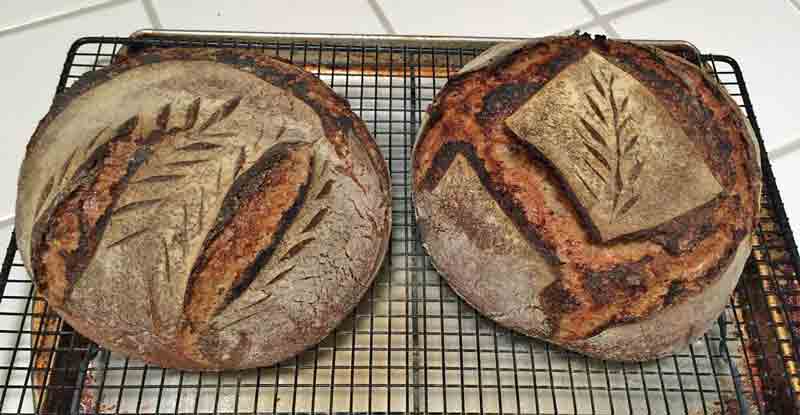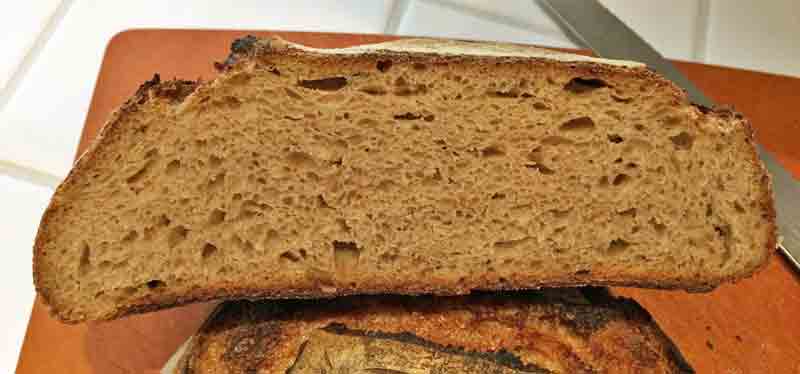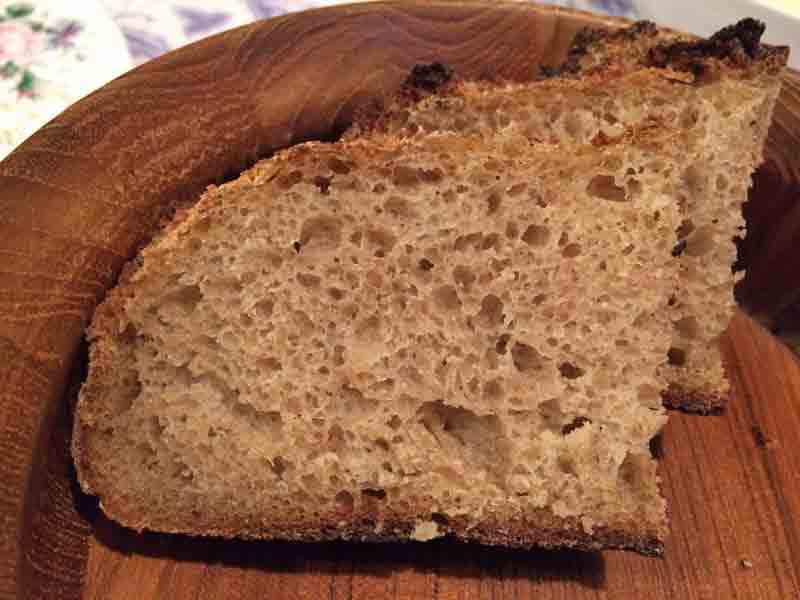
Multi-grain Sourdough Bread with home-milled flour
David Snyder
August 8, 2018
Today's bake is another variation on the multi-grain sourdough breads I have been baking for the past few years. This one has a bit more whole grain flour – 40% versus 30%. Some fresh-milled spelt was substituted for some AP flour. The whole grain flours were milled in a MockMill 100, just before mixing. Because of the higher percentage whole grain flour, I also bumped the hydration up from 78 to 83%.
Total Dough |
|
|
Ingredient | Wt (g) | Bakers' % |
Bread Flour | 600 | 60 |
Whole Wheat flour | 125 | 12.5 |
Whole Rye flour | 175 | 17.5 |
Whole Spelt flour | 100 | 10 |
Water | 830 | 83 |
Salt | 21 | 2.1 |
Total | 1851 | 185.1 |
Levain |
|
|
Ingredient | Wt (g) | Bakers' % |
Bread flour (hi protein) | 144 | 75 |
Whole Wheat flour | 36 | 25 |
Water | 144 | 75 |
Active starter | 36 | 25 |
Total | 360 | 200 |
Dissolve the starter in the water. Add the flours and mix thoroughly.
Transfer to a clean container, cover and ferment until ripe (6 hours for me.) If you don't use it immediately, it can be kept in the refrigerator for up to 3 days.
Final Dough |
|
Ingredient | Wt (g) |
Bread flour (AP) | 440 |
Whole Wheat flour | 85 |
Whole Rye flour | 175 |
Whole Spelt flour | 100 |
Water (85-95ºF) | 670 |
Salt | 21 |
Active levain | 360 |
Total | 1851 |
Procedures
Mix the flours with the water to a shaggy mass.
Cover and let sit at room temperature for 45-120 minutes. (Autolyse)
Sprinkle the salt over the dough surface and add the levain in 4 to 6 portions.
Mix thoroughly. (I start by folding in the salt and levain with a silicon spatula. Then, I use the method Forkish specifies – squeezing the dough between my fingers alternating with stretch and folds in the bowl. I wear a food service grade glove and dip my working hand frequently in water.)
Transfer the dough to a lightly oiled, clean bowl large enough to accommodate doubling in volume. Cover well.
Ferment at 80ºF for 2.5 – 3.5 hours with stretch and folds every 30 minutes for the first 2 hours. The dough should have nearly doubled in volume and be quite puffy.
Transfer the dough to a well-floured board. It will be quite sticky and needs to be handled quickly with well-floured hands, helped by a bench knife.
Divide the dough as desired and pre-shape in rounds. Cover with a cloth and let rest for 20-30 minutes.
Shape as boules or bâtards and place in floured bannetons. Place these in food-grade plastic bags sealed with ties and let proof for 30-60 minutes at room temperature. Refrigerate 8 hours or up to 36 hours at 40ºF.
The next day, pre-heat the oven. Let the loaves sit at room temperature while the oven pre-heats. You can bake on a baking stone, with steam for the first part of the bake, or in Dutch ovens, as you prefer. The oven temperature and length of the bake will depend on which of these methods you choose and on the weight and shape of your loaves, as well as on how dark you prefer your crust. When done, the loaves should sound hollow when thumped on their bottoms. The internal temperature should be at least 105ºF.
Let the loves cool completely on a rack for 1-2 hours before slicing.
These loaves were baked in Cast Iron Dutch ovens at 475ºF for 30 minutes covered, then 20 minutes un-covered.



I tasted this bread about 6 hours after baking. It had a wonderful aroma. The crust was crunchy. The crumb was nicely aerated. It had a cool mouth feel. It was mildly chewy. It tasted moderately sour with a complex flavor and some grassiness. I expect it to mellow considerably by tomorrow.
Addendum 8/9/2018: As expected, after a day, the flavors have melded. It was good freshly cooled. It is significantly better a day later. In fact, it's pretty wonderful. I think the 40% whole grain mix is a "sweet spot." I'm going to be playing with the proportions of the different grains. My expectation is they will all be delicious.
Happy baking!
David
- dmsnyder's Blog
- Log in or register to post comments
It must taste wonderful! I love the scoring! I think I will need to steal your scoring idea!
By the way, I loved your detailed write up! Very easy to follow along to see how you made this particular bread.
Good to see your thorough posts. Always so easy to follow. Lovely bread inside and out. Hope you are doing well. The fires in CA are certainly tragic . We have friends on the " right" side of the lake near Kelseyville. They have kept everything packed just in case. c
I like the sound of the flour combination, I really like rye and you've got a good amount in there.
Love the scoring too!
Happy baking
Ru
too and I can't really disagree. But 30 and 50%, and everything in between, are pretty good too:-) has to taste great! I'm going to start to bake longer with the lid for longer. I usually do 20 minutes but will try 30 minute tomorrow and see how it goes. I always though that the crust would get too thick but never tired it . Very nice baking all the way around
Happy baking David!
Hi David- I hope this is not too off topic, but I have just been offered a Nutrimill from a family member who is upgrading her grinder. I want to know if you have noticed a large improvement in your breads since you have started using fresh-milled flour. Also, do you “age” your milled flour, and do you have any tips for substituting home milled flour in recipes that call for whole grain flours in their formulas. Perhaps you or others can direct me to a good link on this site. I am also wondering if it would be useful to get a fine mesh sifter to make varying extractions.
I thought it might be fun to try milling grains, but thought it might not be worth the trouble, but it is hard to resist a free mill!
—Caryn
I certainly don't regard myself as any kind of home milling expert. I'm pretty new at this and still learning. Specifically, I have no experience with the Nutrimill. From my reading, the Mockmills like the one I have are much quieter and much, much less messy than other makes. With some, it is recommended you only use them out of doors!
I don't find home milling much trouble, and it's kind of fun. I do like the idea of being able to keep a number of different kinds of grains and not worry about spoilage. I will confess, I don't notice a dramatic difference in flavor, but I know the nutritional benefits are there.
I bake one or two loaves once or twice a week. I mill the flour either right before mixing the dough or the night before. I don't "age" it. I have a sifter but I haven't played with it yet. I don't treat home-milled flours any differently than store-bought flours of the same grains.
I know there are lots of folks with tons more experience than I. I suggest you start a new topic asking for mentoring. I will certainly participate. You might also talk to a few vendors who sell the Nutrimill and also other makes, including the MockMills.
Good luck, and Happy baking!
David
David- Thanks for your suggestions. I will especially take your suggestion about starting a forum, but I need to wait a few days when my reaction to the new shingles vaccine wears off.
I just want to let you know that I just made this formula with great success. It is a keeper! I am going to try to keep better track of my bread-baking, so I added to my very occasional blog today. http://www.thefreshloaf.com/node/57785/multigrain-loaf-la-dmsnyder
Thanks for all of your inspirational sharing.
Caryn
Thanks for letting me know. I'm happy you like it. As you may know, I've been playing with the grain mix. My current favorite changes the rye to 75g and the Spelt to 200g in this formula. It increases the gluten in the total dough some. But, as anticipated, all versions have been delicious.
Happy baking!
David